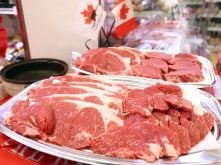There were two distinct price structures for the week ending March 7.
On Monday, March 3, feeder cattle prices were relatively unchanged from the previous week.
However, once the U.S. implemented the blanket 25 per cent tariff on all Canadian products (excluding energy, which was 10 per cent) on March 4, feeder cattle markets dropped by $10 to $15 per hundredweight on average. Prices remained subdued for the remainder of the week, although on Thursday, March 6, U.S. president Donald Trump paused the tariffs until April 2.
Read Also

New World screwworm not seen as trade threat
Canadian cattle producers shouldn’t be worried about the New World screwworm, which has become a massive concern for ranchers in Mexico and is threatening the southern United States
Follow all our coverage of the tariffs situation here
Many auction markets did not hold sales for the week, and volumes were smaller at locations that did hold sales. Many cow-calf producers or backgrounders were selling stragglers or off-grade feeders. This also contributed to the difficulty defining the market structure.
Feedlot operators in Alberta and Ontario shrugged off the threat of tariffs until they were actually implemented. Once the tariffs were implemented, buyers were waiting until Alberta and Ontario packers started purchasing fed cattle to determine where they could buy replacements.
U.S. beef was not on the initial round of Canadian retaliatory tariffs but was on the second round to be implemented in 21 days.
Alberta packers were showing bids on a dressed basis of $420-$430 per cwt. delivered on the morning of March 4, down from the previous week’s range $455-$460 seven days earlier. The feeder market adjusted for this price decrease in the finished market.
In central Alberta, on March 5, Simmental based steers weighing slightly more than 900 pounds on backgrounding ration with full health records traded for $352. This was down from $370 two weeks earlier. Simmental Angus cross heifers weighing 860 pounds on backgrounding ration reportedly sold for $330. This was down a solid $15 from values in the latter half of February.
At the Westlock sale on March 6, a handful of Red Angus cross steers weighing 778 lb. traded for $384. This was down about $15 per cwt. from seven days earlier.
South of Edmonton, a smaller package of Simmental Angus cross heifers weighing 810 lb. sold for $343. This was down from prices in the range of $350-$355 for the same type of heifers the previous week.
Prices in the lighter weight categories were variable.
At the Killarney sale on March 3, Charolais-based steers averaging 599 lb. were quoted at $482.
On March 6, larger frame Simmental-based steers weighing 600 lb. traded at $465 in central Alberta.
At the sale in Prince Albert, Sask., on March 3, black steers averaging 493 lb. were last bid at $557.
At the sale in Ponoka, Alta., on March 5, a handful of higher quality mixed steers averaging 500 lb. sold for $518.
Feeder cattle supplies are not as tight as earlier anticipated.
The U.S. calf crop for 2024 was 33.529 million head, down 33,500 head from 2023. The Canadian calf output during 2024 was 4.296 million head, down 19,000 head from the previous year.
In the U.S., Holstein Angus cross steers are certified Angus beef. We’re seeing more Holstein cross steers move into U.S. feedlots.
On Feb. 1, 2025, the U.S. Department of Agriculture’s Animal and Plant Health Inspection Service announced the resumption of cattle imports from Mexico. Over the past month, the U.S. has imported about 6,00 to 8,000 head per week.
Once the procedures and protocols are more familiar to U.S. feedlot operators in March, we expect that U.S. imports of Mexican feeder cattle will reach 120,000 to 150,000 head per month.
The implementation of U.S. tariffs from March 4-6 made Canadian feedlot operators realize that the tariffs are real, not only a threat. There is going to be a defensive tone moving forward.
There was talk in the trade that the feedlot operators who aggressively bought through March 3 pulled the reins and cancelled feeder cattle orders on March 4.
Look for continued volatility from week to week.
Jerry Klassen is president and founder of Resilient Capital, specializing in proprietary commodity futures trading and market analysis. He can be reached at 204-504-8339 or via his website at resilcapital.com.
















